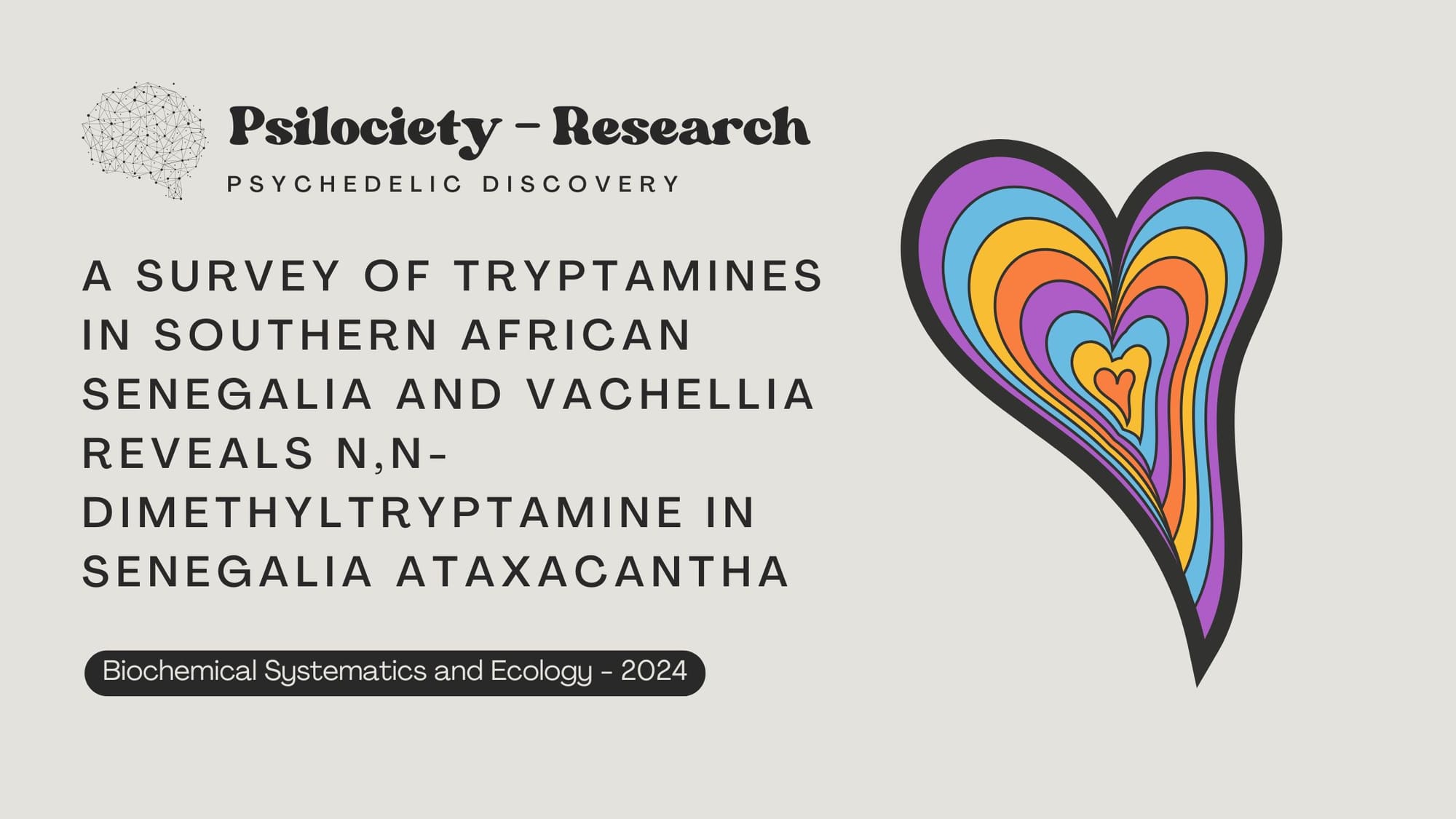A Survey of Tryptamines in Southern African Senegalia and Vachellia Reveals N,N-Dimethyltryptamine in Senegalia ataxacantha
A study analyzing tryptamines in African Senegalia and Vachellia reveals low DMT levels in Senegalia ataxacantha but none in Vachellia species.

Title & Introduction
- Paper Title: A Survey of Tryptamines in Southern African Senegalia and Vachellia Reveals N,N-Dimethyltryptamine in Senegalia ataxacantha
- Published In: Biochemical Systematics and Ecology
- Publish date: October 26, 2024
- Authors: Nicholas Sadgrove, Ben-Erik Van Wyk
- Objective: To investigate the presence of tryptamines and other alkaloids in southern African species of Senegalia and Vachellia to clarify unverified claims of psychedelic compounds in these genera.
- Importance: Despite widespread speculation, little research has systematically examined the presence of N,N-Dimethyltryptamine (DMT) and other tryptamines in African Senegalia and Vachellia species. This study provides crucial chemotaxonomic insights and determines whether these plants contain sufficient quantities of tryptamines for psychoactive use.
Summary & Takeaways
Key Takeaway: DMT was detected in Senegalia ataxacantha at low concentrations (0.01–0.05% wet leaf weight), but no significant amounts of tryptamines were found in Vachellia species. The findings challenge unverified claims about African Senegalia and Vachellia being sources of psychoactive compounds.
Practical Application: The study informs researchers, ethnobotanists, and the psychedelic community about the true phytochemical composition of these genera, guiding future studies on chemotaxonomy and potential medicinal applications.
Key Background Information
- Context: Some online sources and ethnobotanical claims suggest that African Senegalia and Vachellia species contain DMT and other tryptamines, similar to psychoactive Acacia species in Australia and South America.
- Hypothesis: Certain species of Senegalia and Vachellia may contain tryptamines, but at varying concentrations and possibly insufficient levels for psychedelic effects.
Methodology
- Study Design: Chemophenetic analysis of 19 Senegalia and Vachellia species through high-performance liquid chromatography (HPLC) and nuclear magnetic resonance (NMR) spectroscopy.
- Participants: Plant samples were collected from various sites in Gauteng, South Africa.
- Intervention/Exposure: Extraction and quantification of tryptamines, including tryptamine, N-methyltryptamine (NMT), N,N-dimethyltryptamine (DMT), and hordenine.
- Controls: The study compared different plant parts (leaves, bark, flowers, and fruits) and multiple specimens within the same species.
- Duration: Samples were collected and analyzed over multiple months to assess seasonal variation.
Key Findings
Primary Outcomes:
- DMT was detected in Senegalia ataxacantha leaves and flowers at low concentrations (0.01–0.05% wet weight).
- No significant amounts of tryptamines were found in Vachellia species.
- Tryptamine and NMT were detected in some Senegalia species, including S. caffra and S. polyacantha, but not at psychoactive levels.
- Chemical composition varied between specimens, potentially influenced by season, location, or plant organ.
- Unidentified alkaloids were detected in Vachellia, but their structures remain unknown.
Secondary Outcomes:
- Chemical variation suggests possible chemotypes within Senegalia species.
- Some species exhibited intraspecific differences in alkaloid presence, even among specimens growing in close proximity.
- The study challenges previous unverified claims that African Senegalia and Vachellia contain high levels of DMT suitable for entheogenic use.
Interpretation & Implications
- Conclusion: DMT is present in Senegalia ataxacantha but at concentrations too low for psychoactive use. Vachellia species did not contain DMT or significant tryptamines, contradicting previous anecdotal claims.
- Implications: The findings reinforce the need for accurate chemotaxonomic studies in African plant species. Future research should explore geographical and genetic variations in tryptamine expression within Senegalia.
- Limitations: The study was limited to South African specimens and may not reflect tryptamine presence in Senegalia and Vachellia species from other African regions.
Researchers & Publication
- Researchers: Nicholas Sadgrove, Ben-Erik Van Wyk
- Publication Name: Biochemical Systematics and Ecology
- Study URL: https://doi.org/10.1016/j.bse.2025.104993

